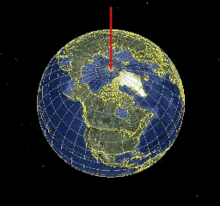ANA MARÍA SEGHESSO
PRECESSION OF THE EQUINOXES
Precession of the equinoxes is called the movement that the earth's axis makes in its displacement around the axis of the ecliptic, drawing a cone and covering the complete circumference of 360º in a period of 25,776 years.
The movement has the effect of "altering the place where the Sun rises", which would correspond to 50.290966 seconds per year, or the equivalent of 1º every 71 years 7 months approximately.
That is to say, that every 71 years 7 months the sun modifies its trajectory - according to our vision from the earth - of 1º.
Together with the sun, all the stars perform the same movement.
The Precession movement of the equinoxes is a much more sophisticated concept to grasp than the rotation and translation movements, discovered many centuries later in Western Europe by Copernicus and Galileo.
The Precession changes the terrestrial vision of the appearance of the sky.
In the Northern Hemisphere: the constellation of Scorpio is visible in summer and that of Orion in winter. Within 12,000 years, at about 180º from the circumference, Scorpio will be winter and Orion will be visible in summer.
Some historians attribute the discovery of the Precession of the equinoxes to Hipparco de Nicaea, dating from 147 to 127 BC. The name of Cidenas is also suggested, who would have discovered this displacement two centuries earlier, in the year 340 BC.
This phenomenon was known many centuries before Copernicus and Galileo formulated the heliocentric theory in the 16th century.
However, the Greek historian Herodotus, mentions in his book "Histories" the Precession of the equinoxes at an earlier date than Hipparco and Cidenas. The discovery belongs to the Egyptian Civilization and the information Herodotus receives goes back 11,340 years before his visit.
Herodotus, was born in Halicarnassus and lived between 484 and 425 BC. He is considered the father of Historiography.
He made numerous trips from which he left many ethnographic anecdotes in his work divided into nine books, "Histories", literally "investigations, explorations".
He transcribes part of paragraph 142 of book II, where he refers to news and stories heard from Egyptian priests in relation to the past generations from the first king of Egypt to the last one who reigned then.
They added up to 341 human generations, and in such a period of time as many were the high priests and kings (pharaohs).
Herodotus describes the Precession of the equinoxes, with the rotation movement of the fixed stars that produces the variation of the movement of the Sun, according to terrestrial optics, with respect to its sunrise and sunset.
Histories, II, 142
“In effect, 300 generations of men represent 10,000 years, since 3 of them complete a century. And the remaining 41 generations, which were added to the 300, result in 11,340 years (1)
Thus, they said, in 11,340 years, no god had been with them in human form. Neither at the beginning nor after, among those who reigned in Egypt, had anything similar been verified.
In that period of time, they reported, the Sun deviated four times from its usual route: twice it would have arisen from where it is now hidden; and where now it arises, twice would have been put; Nothing in Egypt, during all this time, underwent changes, neither the products of the land, nor what the river delivered, not even the process of diseases or the causes of death".






No hay comentarios:
Publicar un comentario